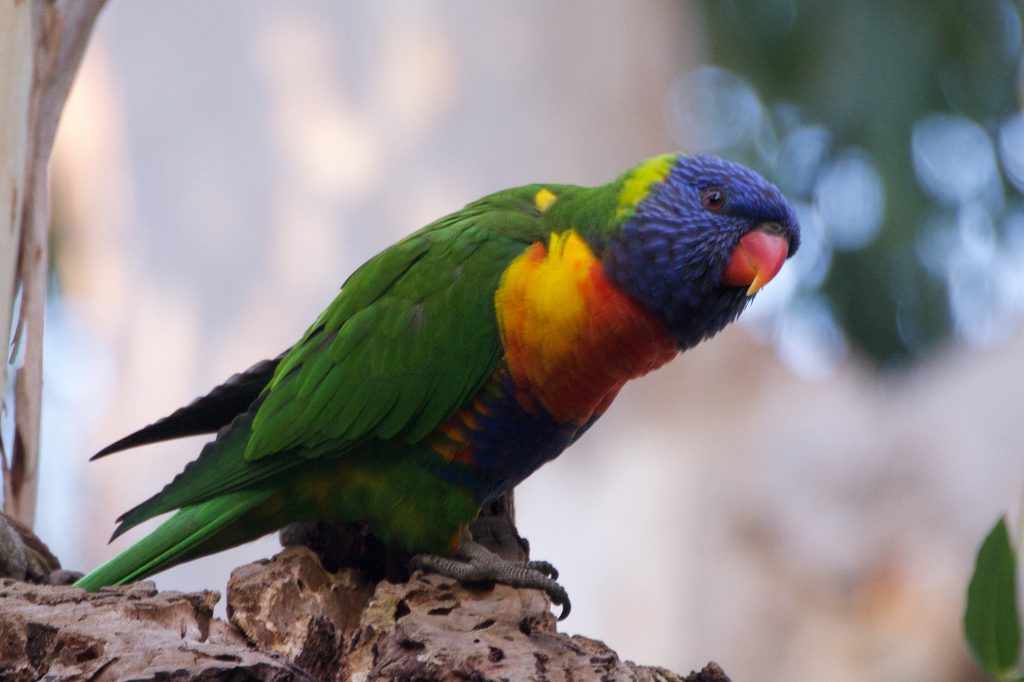The Rainbow Lorikeet is medium-sized parrot species native to the eastern and southern states of Australia. They thrive in a many different environments, including woodlands, rainforests and urban greenspaces. The Rainbow Lorikeet is well established in aviculture and a number of colour mutations have been developed.

Diet
Lorikeets possess a brush tipped tongue which is used to extract nectar and pollen from flowering trees. In captivity; a commercial lorikeet mix and a variety of fruit and vegetables is acceptable. Apple, pear, grapes, tomato and strawberries are particularly enjoyed.
Commercial lorikeet mixes can often be fed dry (in powder form) or wet (mixed with water). Dry food and fresh water should be available at all times, as wet lorikeet food spoils quickly and needs to be replaced several times a day – especially in hot weather.
Lorikeets should not be permitted to consume seed, as it can damage the brush tip on their tongue and contribute to many health issues; many of which lead to a reduced lifespan.
Housing
Due to their high-moisture diet, lorikeets produce a large amount of liquid faeces. A cage or aviary that prevents birds from being able to touch their droppings is essential. This reduces exposure to dangerous bacteria and parasites. Frequent cleaning is necessary and the aviary should be designed to accommodate this. A substrate of sand or gravel that can easily be replaced or pressure-cleaned is needed in traditional style aviaries. Many breeders use suspended flights; which allow droppings to fall through the bottom.
Lorikeets are poor at vertical flight so an aviary at least 3m in length is recommended. Perches should be placed as far apart as possible to encourage distance flight which provides essential exercise.
Rainbow Lorikeets are territorial and will behave aggressively towards other birds. It is advised to house them as single pairs for optimal breeding results. They can be housed in small species-specific colonies, however a large amount of space, multiple feed stations and spare nesting locations are essential to minimize aggression.
Rainbow lorikeets are known to hybridize with scaly-breasted lorikeets, musk lorikeets, red-collared lorikeets and all other species in the Trichoglossus genus. These species should not be housed together or in adjoining aviaries.

Breeding
Rainbow Lorikeets will breed from July through to December, however breeding in other months is not unheard of. They typically produce one clutch per season, though two (or higher) can be achieved if conditions are optimal.
Pair bonds between birds is generally strong, however newly introduced birds may behave aggressively to one another. Injuries or death may occur if the birds are not separated. A relationship between incompatible birds can be formed by housing them in neighboring aviaries.
They will readily accept a wide range medium-large logs and nesting boxes. Nesting sites should be located high in the aviary to prevent vermin from gaining access. The nest box should have a shallow bed of rotting wood, sawdust or pine shavings to provide cushioning. The large amount of liquid faeces produced by young birds will quickly soil the nest box, so it needs to be thoroughly cleaned between clutches. Some breeders drill small holes into the bottom of the next box to allow moisture to escape. It may be necessary to clean the nest box while there are still chicks present, especially if the substrate becomes moist.
Rainbow Lorikeets will begin breeding at between 18 months and two years of age. The male will begin the breeding process through a courtship display of bobbing and hopping. If copulation is successful, the female will lay two or three white eggs which she incubates for 24 days. The young will leave the nest at two months of age.
Health
Due to their high-moisture diet, lorikeets produce a large amount of liquid faeces. If aviary hygiene is not adequately maintained, bacterial and fungal infections can thrive. In traditional aviaries, keeping the substrate as dry as possible is essential. Ensure there is good drainage and a substrate—ideally sand—that can be frequently replaced.
Similarly, it’s also important that a lorikeet’s food supply is not permitted to spoil. Fruits, vegetables, and “wet” lorikeet food should be removed on the same day as it’s placed in the aviary. In hot weather, food will spoil more quickly so it may be necessary to provide multiple feedings throughout the day.
A preventative worming and parasite control regime should be applied to ensure the long-term health of your birds.
A healthy rainbow lorikeet should have an expected lifespan of approximately 20 years.
Hi There, what wire do you recommend for a rainbow lorikeet? 12.5 mm x 12.5 mm x 1.25 or 25 mm x 25 mm x 2.5 mm??? Thanks
12.5 mm x 25 mm or 20 mm x 20 mm (1/2″ x 1″ or 3/4″ x 3/4″) Welded mesh would be fine. I personally use 3/4 x 3/4″ on my cages. Use galvanized wire clips to join the wire panels. Do not expose a wooden frame inside of any Lorikeet or Parrot cage.